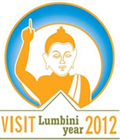Ganesh Himal Region Quick Facts
Best time to visit: All season (views are clearest from fall to spring)
Environment: Mid to high-hills
Maximum elevation: Dobra Danda (Ganesh Himal Viewpoint), 4341 m (14280 ft)
Minimum elevation: Bhalche Gaon 1860m
Facilities: Camping, lodges and hotels, teahouses, home stay (agencies can arrange all details)
Duration: One to three weeks
Accessibility: road connection including two major highways (Prithvi and Tribhuwan)
Difficulty level: Easy to moderate with advanced options, too; best explored with guide
Formalities: Nepal Visa on arrival ($25 USD for 15 days, $40 USD for 30 days, or $100 USD for 3 months); Langtang National Park Entry Fee, 3000 NRS ; Trekking Information Management System (TIMS) card, $20 USD, will be checked if passing through Dhunche (rather than walking in from Betrawati or from Dhading Besi as well as from Trisuli Deurali)
Food and lodging costs: Minimal
Typical Nepali dish: daal-bhat tarakaari (rice, lentil soup and vegetables)
Typical drink: Chiya (sweet milk tea)
Highlights: Gurung, Ghale, Tamang, Brahmin, Chhetri, Dalit, Newar, Chepang ethnic groups, cultural interaction, village scenery and lifestyle, Nepali hospitality, Himalayan panoramas, sacred lakes including, Ganesh Kunda/lake, Parvati Kunda, Seto and Kalo lakes, waterfalls, hot springs, Hindu Temples Tripursundari Temples, Buddhist monasteries, cheese factory, Ganesh Himal viewpoints, herbal plants, crystal and ruby and zinc mining, dances and festivals, historical sites, unexplored territory, rare and exotic wildlife.
The Journey to Ganesh Himal And The Ruby Trek
 Dhading, Gorkha, Rasuwaa and Nuwakot districts are at the geographical center of Nepal and lie at the heart of the nation's history. It is from these hills that Gorkha hillsmen, led by Prithvi Narayan Shah, set out to unite Nepal in the late 1700s. Since then, Gorkha soldiers have received international fame for their bravery and skill as warriors.
Dhading, Gorkha, Rasuwaa and Nuwakot districts are at the geographical center of Nepal and lie at the heart of the nation's history. It is from these hills that Gorkha hillsmen, led by Prithvi Narayan Shah, set out to unite Nepal in the late 1700s. Since then, Gorkha soldiers have received international fame for their bravery and skill as warriors.
Although near to both Kathmandu and Pokhara, the Ganesh Himal Region has remained a well-kept secret to all but Nepal's most avid trekkers. The unexplored area is concealed between the popular destinations of Langtang National Park and the Mansaslu Conservation Area Project.
Wildflowers flourish, and waterfalls embellish the lush hill scenery in a land blessed with wide-ranging geographical, cultural and biological diversity.
Sensational viewpoints feature the sublime Himalaya to the north. Most prominent is the Ganesh Himal Range, a family of peaks among the most attractive of the entire Himalaya. The Ganesh massif is named in honor of Hindu deity Ganesha, son of Shiva and Parvati. Selected viewpoints in the area offer immense panoramas!
Most rewarding are the cultural attractions including magnificent Ganga Jamana a twin waterfall, Kalo, Seto lakes and Ganesh kunda/lake, and Tripurasundari temples and especially the hospitable people that inhabit the region. The area is populated mainly by Tamang Gurung, Ghale, and to the north, and Brahmin, Chhetri, Dalit, Newar and Chepang at the lower elevations in the south. Visitors are warmly welcomed by all with a friendliness that makes Nepal legendary.
At least six separate trekking itineraries are recommended and await travelers promising unforgettable adventures. Government registered trekking agencies will be happy to set up visitors with a guide and all necessities for exploring this captivating, undiscovered region.
The area is easily accessed by the Prithivi Highway as well as Pasang Lhamu highway along the southern fringes, connecting Kathmandu and Pokhara. Another adventurous option is to hike in from the Tamang Heritage Trail of Rasuwa and follow the Ruby Trek, so named for the precious stones harvested in the area.
We will take you along this route with dramatic scenes of natural beauty, village scenery and cultural charm.
Ganesh Himal Cultural Home Stay challenging Trekking – 7 days
Day 1 Kathmandu to Shyabru Besi 1503m/4945Ft. 8-9 hrs drive
Taking local bus early in the morning or a private four wheel drive journey from Kathmandu reaches Shyabru Besi, gateway to the Langtang Valley at the confluence of the Bhote Kosi and Langtang Rivers. Mesmerizing scenic driving and passing through Trisuli Bazaar, Ramche Gaon and Dhunche Bazaar makes you scenic driving. Narrow and bit adventurous zig zags road but amazing landscape along the way driving will make you good start day drive of the trek.
Day 2 Shyabru Besi to Chawatar (lunch) to Gatlang 2337m/7690ft. 5- 6 hrs hike
A dirt track zig-zags to the west up to Bahun Danda Pass and then down to the Tamang settlement of Gatlang, a cornerstone village on the Tamang Heritage Trail or hike to Gatlang by way of Chawatar. Gatlang is a Tamang village with unique customs and craftsmanship in a magnificent setting. Above lies Parvati Kund, popular during Janai Purnima when thousands of pilgrims are attracted to the sacred pond and nearby temple.
Day 3 Gatlang to Parvati Kund ,Yuri Kharka (lunch) to Somdang 3271m/10760Ft. 6-7 hrs
The trail ascends through pine and rhododendron forest to a lunch point of Yuri Kharka before continuing to Khurphu Bhanjyang and then dropping down to the Somdang River, border between Rasuwaa and Dhading districts.
A sprawling mining compound, no longer functioning but it seems locals appealing government to revive it, lies a few hours to the north upriver. The hike passes through a scenic valley featuring the 200 m Chukarma Waterfall. The former mine leaves a lot be explored and is the site of a 1.4 km tunnel bored into the mountain to extract zinc, copper, tin, crystal and even highly-prized rubies.
Day 4 Somdang - Pangsang Pass (3842 m) - Tipling 2078m/6835Ft. 6-7 hrs
Pangsang Kharka is a viewpoint southwest of Somdang village with a broad panorama of the surrounding terrain. To the north are the soaring peaks of Manaslu and the Ganesh Himal Range. The large meadow is graced with a giant entry gateway and is a sensational location for camping and taking in the breathtaking scenery. The whole Ganesh Himal region is blessed with abundant herbal plants. Previously, herbs were taken to Tibet along an ancient trade route and exchanged for salt, livestock, wool and turquoise.
Descend to Tipling, a large village that hosts two Buddhist gombas and both a Protestant and Catholic church. Along a ridge top to the east is a gomba and cremation ground for both Buddhists and Christians lined with colorful flags. Being a majority of Tamang people it has beautiful Tamang culture show. Tamang people have own rich culture to show for the visitors jhankri or shaman dance, ghode or horse dance, said to have been brought from Tibetan culture long ago. Jhankri (shaman) activity is robust in this territory with the worship of natural forces and indigenous local deities interwoven with Hindu and Buddhist practices. Mane dance, Mendo Maya, Paru dance and Ghode (horse) dance as well as Lama (monk) dance are quite popular.
Day 5 Tipling – Shertung/Chalish – Borang Village 1700m/5610Ft. 5- 6 hrs
 Descend to cross the Adha Khola on a box bridge and ascend to the sister villages of Shertung and Chalish, regally overlooking the fertile river valley and abundant fields.
Descend to cross the Adha Khola on a box bridge and ascend to the sister villages of Shertung and Chalish, regally overlooking the fertile river valley and abundant fields.
Shertung is inhabited mainly by Tamang. The name Shertung means 'place of gold'. According to a legend , two brothers in search of gold were led here by a dream and thus the settlement was born. Tamang people have own rich culture to show for the visitors Jhankri or shaman dance, ghode or horse dance, said to have been brought from Tibetan culture long ago. Jhankri (shaman) activity is robust in this territory with the worship of natural forces and indigenous local deities interwoven with Hindu and Buddhist practices.
Chalish is inhabited primarily by Gurung, Ghale and Kami. There used to be Newar people but they migrated to Kathmandu city. The hospitable people of this area have unique customs and craftsmanship and traditional dances, including a hospitable welcome dance, Ghatu Dance, Dohori is also popular with call and response between male and female participants, a type of courtship ritual, complemented by folk music. Some dances depend on the time of year and take place during festivals including the Maruni Dance during Dasai and Tihar, Hai Nelo Dance of Tihar, and the Ghatu (Ghasiri Dance) that occurs during Chandi Purnima in the Nepali month of Chaitra. Gurung men traditionally wear vangra, a woven, embroidered cotton cloth tied at the ends that serves as a pouch for carrying goods. Sri Tinkanya Devi Mandir lies above Chalish. Local women tie bits of cloth or leave a bangle representing a wish to be fulfilled near a small pool of water surrounded by Barmase or periwinkle flowers. Have lunch in Shertung or in Chalish village and then trek continue to Boring. If you have lunch at Shertung village you trek to Borang via Ayui village whereas trekking via Chalish will be passing through Gobre gaon. Borang village also the Tamang community village and similar culture of Tipling and Shertung village will be found.
Day 6 Borang - Percho (lunch) to Darkha Gaun 850m/2805Ft 7-8 hrs
After breakfast trek all the down to Lishne khola (2 ½ hours walking) and trek continue to Percho where stop for lunch and trek continue to Darkha Gaon. Passing through suspension bridges, breath taking views of Ankhu khola and Chyamchyat as well as Ri village other side of the river finally reach at Darkha gaon. This village is mix culture village of Brahmin people and Tamang as well ad Dalit.
Day 7 Darkha Gaun – Darkha Phedi - Dhading Besi – Kathmandu 1310m /4323ft 6 -7 hrs drive
After breakfast trek all the way down to Darkha Phedi taking 45 minutes down hill walk and then take sharing local Jeep with other people and the arrive in Dhading Besi after 3-4 hours rough and tough zig –zags road. Crossing through Ankhu Khola as well as Kimdang phedi villages as well as Katunje and Jyamrung village will make you fun driving having fabulous landscape surroundings. From Dhading change another bus and drive back to Kathmandu taking 3 hours Prithivi high way drive.
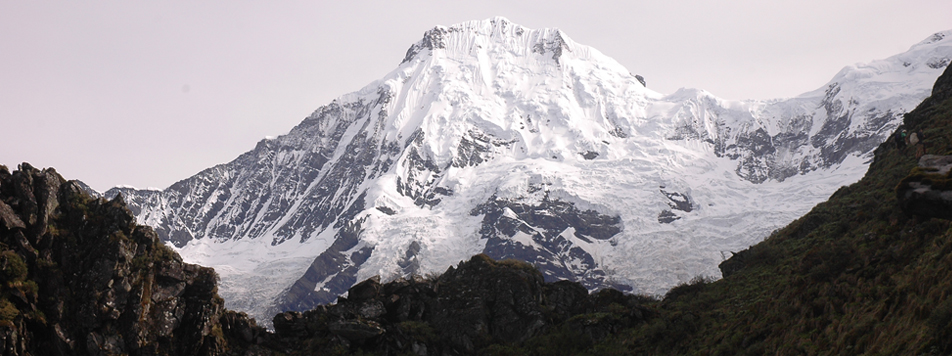 Ganesh Himal (7422m.)
Ganesh Himal (7422m.)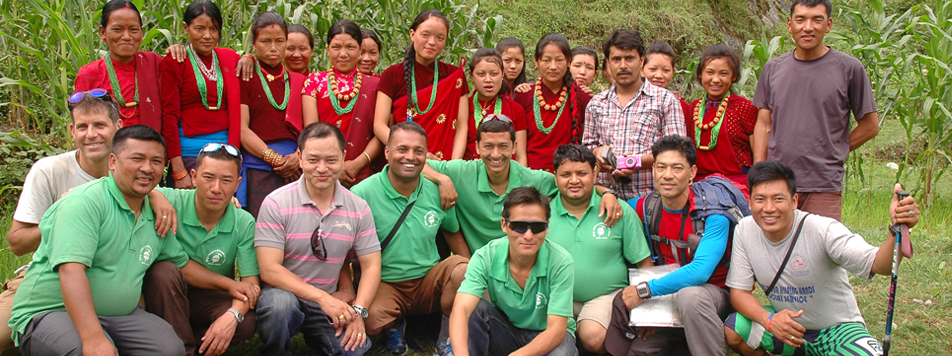 Explore Team with Gurung Women
Explore Team with Gurung Women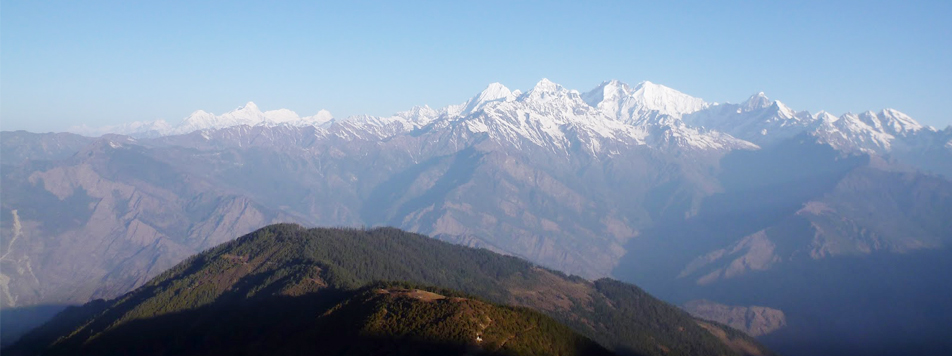 Ganesh Himal Treks (View from Sing La Pass 4050m.)
Ganesh Himal Treks (View from Sing La Pass 4050m.) Explore Team for Press Meet
Explore Team for Press Meet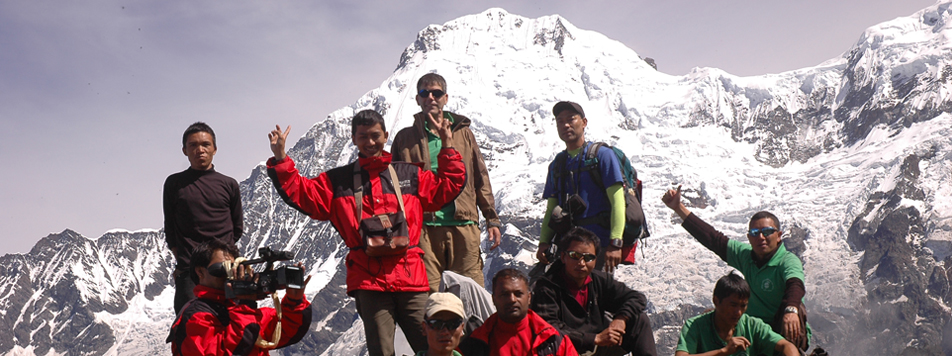 Ruby Valley Ganesh Himal Trekking (Kalo and Seto Kunda View Point)
Ruby Valley Ganesh Himal Trekking (Kalo and Seto Kunda View Point)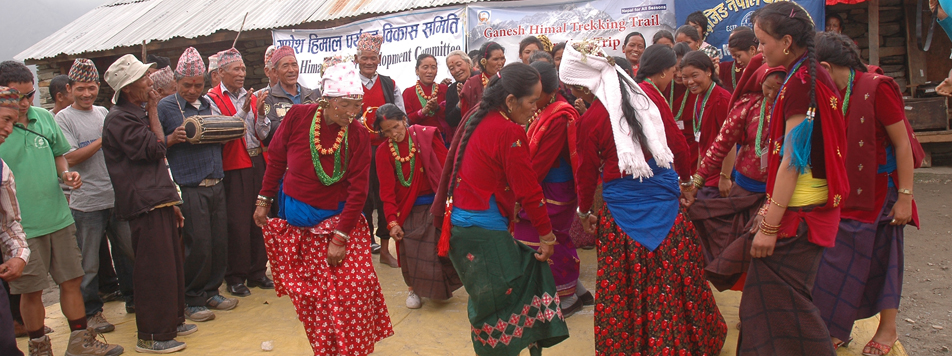 Gurung Ghatu Dance
Gurung Ghatu Dance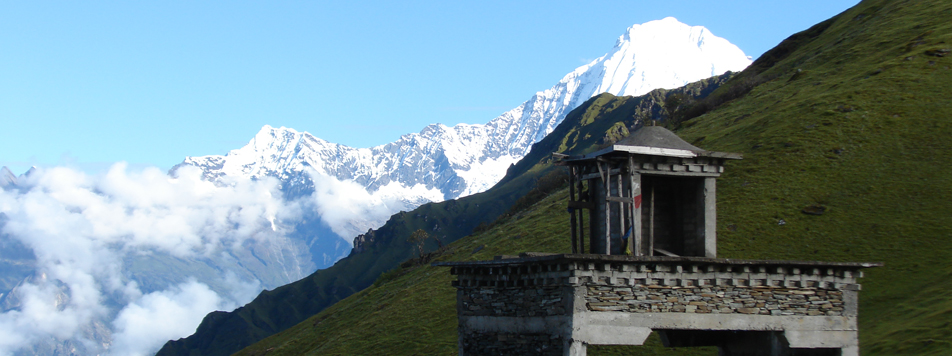 Pangsang Pass (3850m)
Pangsang Pass (3850m)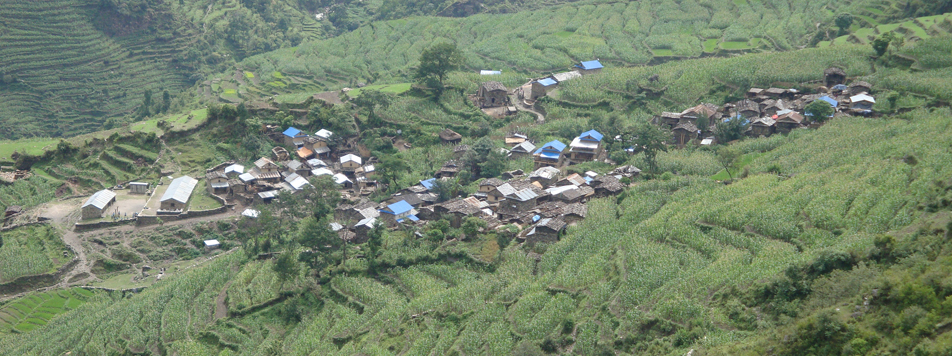 Ganesh Himal Chalis Gaon
Ganesh Himal Chalis Gaon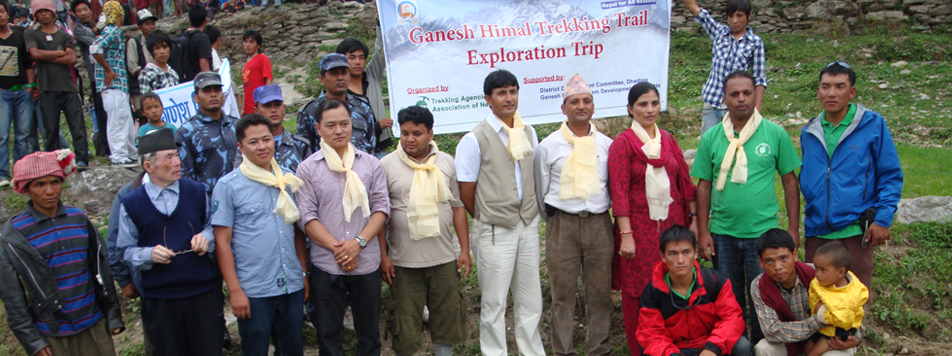 Group Photo with CDO and LDO
Group Photo with CDO and LDO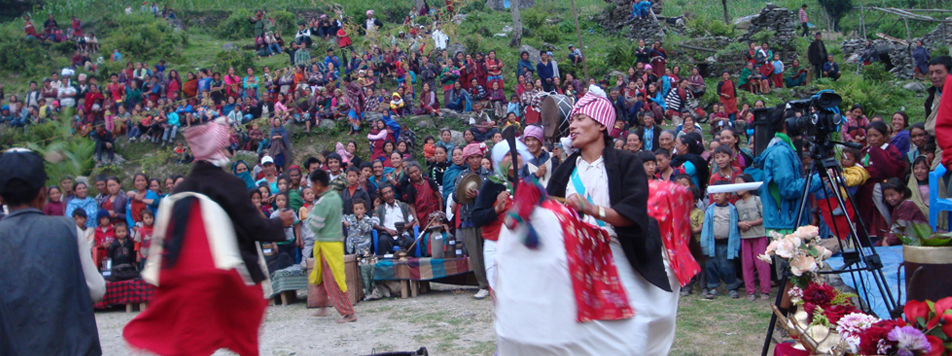 Tamang Mane Dance
Tamang Mane Dance Dhading, Gorkha, Rasuwaa and Nuwakot districts are at the geographical center of Nepal and lie at the heart of the nation's history. It is from these hills that Gorkha hillsmen, led by Prithvi Narayan Shah, set out to unite Nepal in the late 1700s. Since then, Gorkha soldiers have received international fame for their bravery and skill as warriors.
Dhading, Gorkha, Rasuwaa and Nuwakot districts are at the geographical center of Nepal and lie at the heart of the nation's history. It is from these hills that Gorkha hillsmen, led by Prithvi Narayan Shah, set out to unite Nepal in the late 1700s. Since then, Gorkha soldiers have received international fame for their bravery and skill as warriors. Descend to cross the Adha Khola on a box bridge and ascend to the sister villages of Shertung and Chalish, regally overlooking the fertile river valley and abundant fields.
Descend to cross the Adha Khola on a box bridge and ascend to the sister villages of Shertung and Chalish, regally overlooking the fertile river valley and abundant fields.
